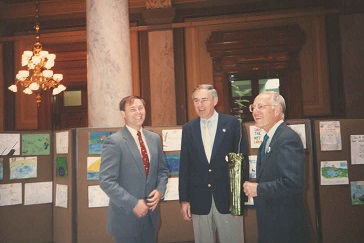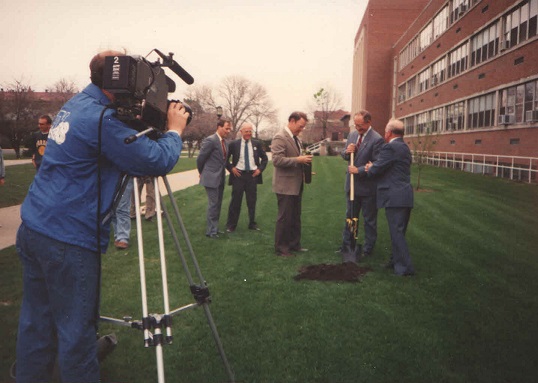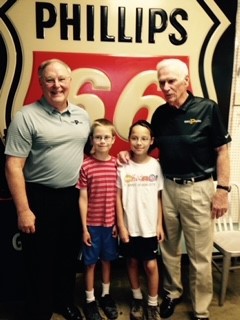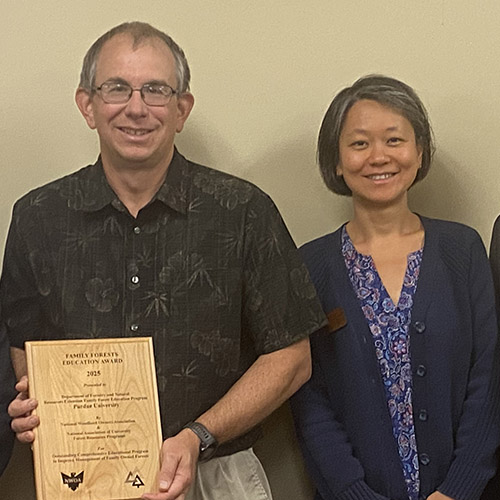Space Sycamores: A Legacy of Hope, Friendship
More than 30 years ago, two Purdue alums - one a forester, one an astronaut - worked together to cultivate and plant sycamore trees across the state that were grown from seeds that were taken to outer space in 1988.
The project, which began as a way to give back to the 4-H community in Indiana, not only stands as a symbol of lasting hope, but also sparked the beginning of a years-long friendship.
“I didn't succeed the first time I applied for test pilot school or the astronaut office but I didn't let those setbacks stop me,” retired U.S. Air Force Lieutenant Jerry Ross said. “I persisted and with the help of God I believe I was able to achieve those goals and to do them in spades with seven flights and nine space walks. I wanted to share my experience with 4-H youth all over the state of Indiana and to help them believe that they can do whatever they want to do if they study hard enough, work hard enough and don't give up too easily in the pursuit of their dreams. The fact that there are still a lot of the trees out there, and that it has been redocumented tells me exactly what I was hoping for occurred.”
The Forester
Walter Beineke came to Purdue in 1956 to work on his forestry degree. After graduating in 1960, he took four years to earn his master’s degree in silviculture at Duke University and his PhD in forest genetics at North Carolina State University.
In 1964, Beineke returned to West Lafayette and joined the faculty in the Department of Forestry and Natural Resources. He received many awards including outstanding teacher (7; 1972, 1973, 1986, 1988, 1992, 1997, 1998) and outstanding advisor (2; 1990, 1997) in Purdue FNR. Beineke taught dendrology, applied forest tree improvement, and world forestry and society. He retired in 1998 and was named professor emeritus.
“I think I was born with an interest in trees,” Beineke said. “Even at five years old I was planting acorns in my mom’s flowerbeds, which did not make her very happy. And then my father planted a tree in the backyard that he dug up from the bushes in the front and he was sure it was an oak tree. That’s where my interest in tree identification came from because I was sure it was not an oak tree and that it was really a silver maple. I got books from the library on tree identification to prove to him that it was not an oak tree. Then as a Boy Scout I was involved with teaching summer camp courses for conservation and forestry merit badges. It was just natural to go to Purdue and major in forestry. Also, one of my best friends decided to major in forestry and he convinced me that we should go together.”
Beineke worked on the genetic improvement of black walnut for timber purposes for over 40 years with emphasis on vegetative propagation, superior tree selection, progeny testing, seed orchard establishment, control pollination techniques and plantation management.
Beineke received the American Black Walnut Research Award in 1985 presented by the Walnut Council for “outstanding accomplishments in the development of practical procedures and improved techniques in the growing of American black walnut trees for the future.”
He is the author of over 100 papers and book chapters on walnut genetics and management and the holder of patents on 21 black walnut trees, nine with Purdue University (the first trees ever patented for timber purposes and 14 with Arbor America (the first timber trees patented partially on the basis of DNA fingerprinting with the help of HTIRC at Purdue. He also holds the first patents on black cherry and white oak, one each with ArborAmerica. Over 4000 acres of patented black walnut are planted worldwide.
Beineke is a charter member of The Walnut Council. He is also a member of the Society of American Foresters, the National Woodland Owners Association, American Tree Farm Association, The Nature Conservancy and NICHES Land Trust.
The Astronaut
Astronaut Jerry Ross graduated from Purdue in 1970 and 1972 with a bachelor’s degree and master’s of science in mechanical engineering. Ross, who shares the record for number of launches into earth orbit with seven space shuttle missions, was inducted into the Astronaut Hall of Fame in 2014.
A member of the Air Force ROTC at Purdue, Ross took an educational delay after finishing his bachelor’s degree, which allowed him to stay in West Lafayette to earn his master’s degree before entering active duty. His first assignment in the Air Force was in the aero-propulsion laboratory at Wright-Patterson Air Force Base in Ohio, but Ross’ goal since the fourth grade had been to get involved in the space program.
Fortunately, in 1972, the National Aeronautics and Space Administration (NASA) was just beginning to build the space shuttle. The shuttle was going to need two different types of astronauts: pilots to fly it, as well as a category called mission specialists made up of engineers, scientists and medical doctors, who would perform the spacewalks, operate the robotic arms and conduct scientific experiments.
Air Force test pilot school opened up classes to include flight test engineers. Ross applied for the school twice and was selected on his second go round, eventually graduating in 1976.
“I had a great time in the school. I learned a lot,” Ross recalls. “It gave me the opportunity to fly as a flight test engineer on a B-1 bomber, which was then the Air Force's highest priority test program. That gave me great visibility and a lot of experience. While I was working on that program NASA announced the first selection of new astronauts for the space shuttle program and I was one of about 8,000 people or so that applied. I was really excited when I was one of 210 that NASA invited down to Houston for a week-long series of medical examinations and an interview. But I was very, very disappointed when I wasn't one of the 35 that were selected that time around.”
In another showing of perseverance, Ross called the head of the selection panel, who asked him to consider moving to Houston to work and to allow both parties to become better acquainted.
Seven years after entering the Air Force on active duty in 1972,
Ross was assigned to the Payload Operations Division at the Lyndon B. Johnson Space Center. In 1980, he was selected as an astronaut, this time making the cut of just 19 individuals selected out of the 6,000 people who applied and 120 who were interviewed. Ross took his first spaceflight in 1985 on the STS-61-B Atlantis, during which he conducted two six-hour space walks.
On his second mission, the STS-27, on the Space Shuttle Atlantis, Ross was mission specialist 2. It was on this four-day mission (Dec. 2-6, 1988) that Ross carried four seed packets of sycamores, sweet gums and tulip poplars to space to germinate, from which the storied Space Sycamores were grown.
Ross went on to take five more spaceflights (1991, 1993, 1995, 1998 and 2002) before retiring in 2012. He earned 15 NASA medals in his career and also garnered the American Astronautical Society’s Victor A. Prather Award for space walking achievements three times and the society’s flight achievement aware four times.
Ross formerly held the record for U.S. spacewalks (9) and space-walking time (58 hours, 18 minutes), but both of those have since been surpassed.
The Space Trees Project
Ross’ idea to bring seeds into space was not a new one. In 1983, more than 25 pounds of seeds of a variety of fruits and vegetables were launched into space on the Challenger space shuttle’s Mission STS-6. In 1984, millions of tomato seeds were sent on Challenger’s Mission STS-41C as part of NASA’s Long Duration Exposure Facility project.
Ross also followed in the footsteps of fellow Purdue astronaut Charles Walker, whose crew took 200 sweet gum seeds aboard the space shuttle Discovery in 1984. Five of these “shuttle gum” trees are planted around the Purdue campus.
“As an astronaut you get to fly a limited number of items for yourself, but also a smaller number of items for organizations,” Ross explained. “I tried to use those opportunities to recognize and thank organizations that I had participated in and who I thought helped to shape me and mold me and who gave me that push that ultimately got me selected to become an astronaut. Certainly 4-H was one of those.”
Ross approached Dr. Ed Frickey, who acted as the 4-H Coordinator in the Purdue Extension Office, about the seed project. Frickey coordinated things through the School of Agriculture and procured the seeds – sycamore and tulip poplar - through Purdue FNR. The end goal was the goal to plant a space sycamore in all 92 counties, at extension offices, 4-H centers, county fairgrounds and several state buildings.
When Ross returned from space, he needed help to grow the seeds into trees ready to be planted.
Enter Beineke.
“Jerry brought the seeds back from space and they wanted somebody to grow the seedlings,” Beineke explains. “I was in charge of the greenhouses out at Martell Forest and was doing work with black walnut. I grew a lot of seedlings as part of my research, so they said, why don’t you take these and grow them in the greenhouse into seedlings and then we’re going to plant them across the state. So, that’s what I did.”
Beineke cared for the seeds over the next year and a half and in the spring of 1990, he called Ross to let him know the seedlings were ready for planting.
The pair then set off on a journey throughout the state planting space sycamores, including a stop in Indianapolis where Ross presented a tree to then governor Evan Bayh on April 10, which was eventually planted on the capitol grounds.
Space sycamores were planted at several 4-H Centers as well as the school for the blind and the state fairgrounds, Beineke recalls.
Ross helped plant one of the space sycamores at the Lake County Fairgrounds in his hometown of Crown Point, Indiana.
A space sycamore was planted in front of the Lilly Hall of Life Sciences on campus at Purdue on April 19, to celebrate the 60th anniversary of Purdue extension. Beineke was on hand for the planting alongside Ross, Dr. Greg Shaner, Dr. Henry Wadsworth and Dr. Kramer.
The plaque at the base of the tree by Lilly Hall states that ““This tree was grown by the department of forestry from a seed which orbited the earth on the United States Space Shuttle Atlantis from December 2-6, 1988, as part of a 4-H project. It is planted in honor of the 1989 diamond anniversary of extension service to the people of Indiana by the Purdue University School of Agriculture and the Department of Botany and Plant Pathology.”
When the trees were planted across the state, Ross gave several of the remaining trees back and told him to plant them at his discretion. One was placed in Martell Forest and Beineke planted another on his own property just down the road from Martell.
Ross also gave space sycamores to his two sisters, Jan Rattazzi and Judi Futa, who now live in Crown Point and Granger, Indiana, as well as his best friend, Dr. Jim Gentleman. Gentleman still has the tree in his backyard, and Rattazzi even took hers with her when she moved.
The Friendship

In 2013, Ross published his book “Spacewalker: My Journey in Space and Faith as NASA’s Record Setting Frequent Flyer,” and came to Purdue to do a signing with co-writer John Norberg.
“I took my wife and my grandkids and their mom over to have him sign a book for us,” Beineke remembers. “I had just written a book myself called Purdue Number One. It's a book about my experiences at Purdue and a lot of the history of those days. In one of my chapters I have a paragraph about the space trees and Jerry Ross and so forth. Well when we got up to the table and finally introduced ourselves he recognized me right away and stood up and just hugged me and everything. There were about 50 people in line behind us getting very angry because we must have spent 15 minutes there. John Norberg was there too and got to meet him and of course the grandkids got pictures with him. Then I said by the way here's a signed copy of my book and I said I'd like for you to sign a copy of your book. I said and on page such and such there's a description of the space sycamore deal that we did. He said well that's kind of funny because in my book on page blah blah blah there's a paragraph about you, so we had a lot of laughs over that.”
Upon reading Beineke’s book, Ross found an even deeper connection between the two and recalled fond memories.
“I do distinctly remember him coming up when I was doing a book signing there in the union building on campus and he brought several of his grandsons with him and I think his daughter as well and we had a great time talking there and then he subsequently sent me his book,” Ross remembers. “I had a great time reading it and I was really tickled to see how similar in many ways our boyhoods had been growing up in the Midwest, but I really have enjoyed getting to know Walt and meeting some of his family members. He's a fine gentleman and I really did appreciate what he did to help get those trees ready to go plant.”
Another chance encounter came a few years later when Ross was in town to film some commercials for Purdue Federal Credit Union. Beineke found out by chance that Ross and fellow astronaut Gene Cernan were eating breakfast at Route 66 Diner and decided to drop by and say hello to his old friend.
“I took my grandchildren and we went over and went in to have breakfast,” Beineke said. “We were just going to eat breakfast and maybe wave or something. We didn’t think anything more. Jerry saw us and said Walt come on over and so we got to meet Gene Cernan and I have pictures with my grandsons and both Cernan and Jerry. It was probably two years before Cernan died. So we ate breakfast with him that morning and I think that's the last time I've seen him or communicated with him at all, but it's been a really good relationship.”
Of the breakfast meeting, Ross says, “I thought it was really neat that he found out that we were there and brought his grandkids with him. We really enjoyed seeing him that day. It was a lot of fun.”
“I think this story is just typical of many different stories that I've experienced through my years of association with Purdue and I think everybody else that is attached to Purdue in any way has very similar stories. The people there are genuine.
They're trying to help in any way they can, they cherish the relationships that they establish over the years and this is just one of many that I have been able to establish and enjoy.”
The Legacy
In 2020, the 30th anniversary of the plantings, Purdue Extension’s Kristi Whitacre and Daniel Walker created an interactive story map of the remaining trees. The Allen County Extension office also shared a story about “The Tree from Space at Fox Island” last year.
The space sycamore that remains on the Purdue campus is part of the Space Walks gold tour.
“It is a great sense of accomplishment to have space trees planted around the state that I had a small hand in,” Beineke said. “Jerry was the one that had to go into space with all of those dangers and unknowns, I just sat on the ground and planted seeds. But, probably the best part of it was the honor of getting to know and spend time with Jerry and his family.”
The Ross Family: A Legacy with NASA and Purdue
Ross’s daughter Amy is a Purdue grad two times over with a bachelor's and master's in mechanical engineering.
“She was a Beering scholar and she worked on the final development and certification of the gloves that I wore on several of my spacewalks,” Ross explained. “I was really excited to be the first one to test those gloves in orbit so it was pretty cool. She's still working at NASA and has been leader of a team of engineers that's designing the new spacesuit that probably eventually will be the one that is used on the surface of the moon.”
His wife, Karen, who was a member of the Purdue Department of Nutrition Science 2010 Hall of Fame class, also impacted Jerry’s time in space.
“My wife is also a Purdue grad in home economics and she worked for the company (United Space Alliance) that provided the food that we ate in space,” Ross said. “She was the leader of that team so I got to have home-cooked meals so to speak when I flew in space for quite a few of my flights.
“We've had a family enterprise for some time in the space business, but Amy is the only one still carrying the fire at this point. My wife and I are both enjoying retirement.”
The Ross Family: A Legacy with NASA and Purdue
Ross’s daughter Amy is a Purdue grad two times over with a bachelor's and master's in mechanical engineering.
“She was a Beering scholar and she worked on the final development and certification of the gloves that I wore on several of my spacewalks,” Ross explained. “I was really excited to be the first one to test those gloves in orbit so it was pretty cool. She's still working at NASA and has been leader of a team of engineers that's designing the new spacesuit that probably eventually will be the one that is used on the surface of the moon.”
His wife, Karen, who was a member of the Purdue Department of Nutrition Science 2010 Hall of Fame class, also impacted Jerry’s time in space.
“My wife is also a Purdue grad in home economics and she worked for the company (United Space Alliance) that provided the food that we ate in space,” Ross said. “She was the leader of that team so I got to have home-cooked meals so to speak when I flew in space for quite a few of my flights.
“We've had a family enterprise for some time in the space business, but Amy is the only one still carrying the fire at this point. My wife and I are both enjoying retirement.”












